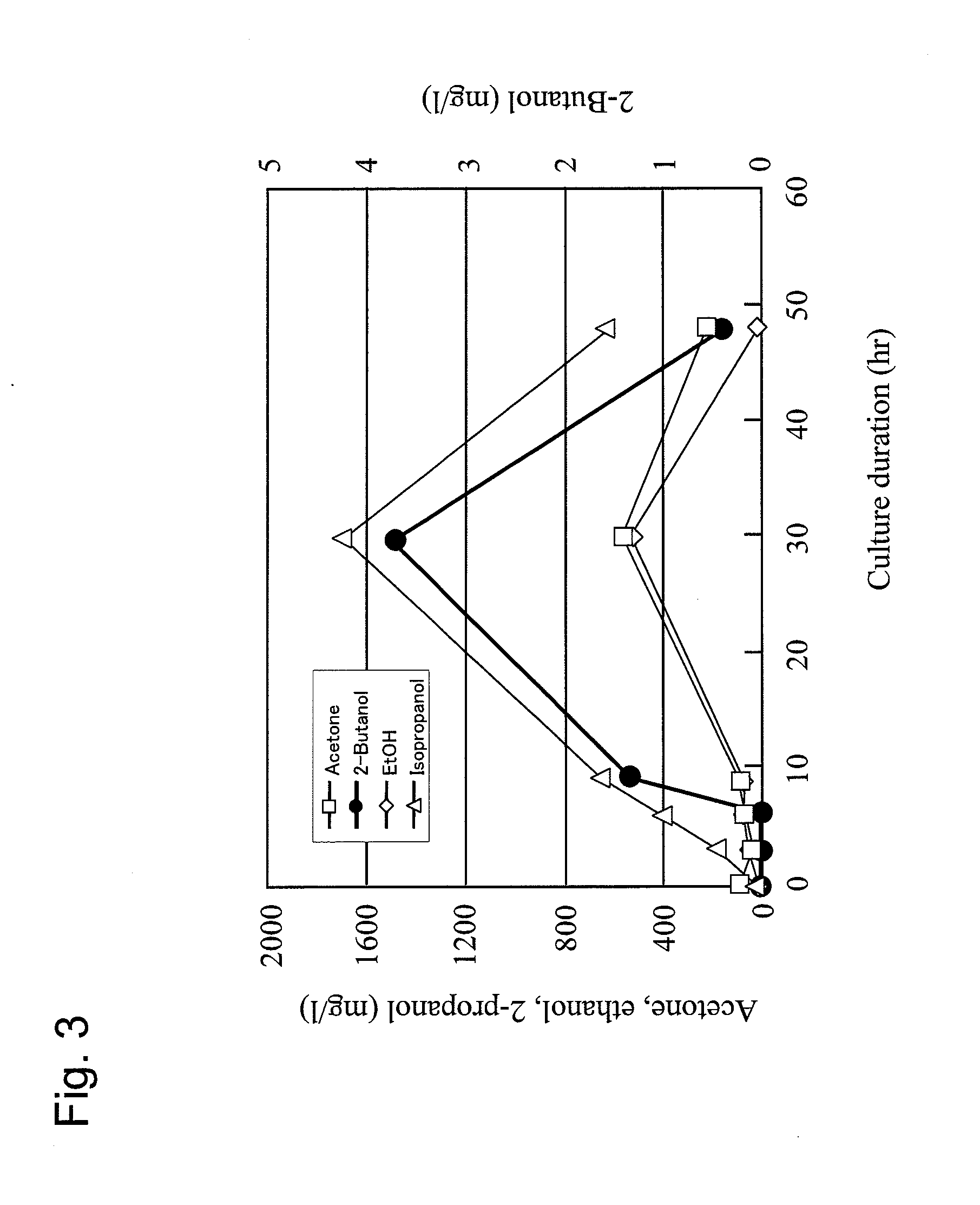Method for producing 2-butanol and recombinant microorganism having 2-butanol production capacity
a technology of recombinant microorganisms and 2-butanol, which is applied in the direction of carbon-carbon lyases, transferases, lyases, etc., can solve the problems of high purification cost, low method productivity, and difficult mass production, so as to improve the productivity of 2-butanol used for fuel or resin materials, the effect of reducing the cost of butanol production
- Summary
- Abstract
- Description
- Claims
- Application Information
AI Technical Summary
Benefits of technology
Problems solved by technology
Method used
Image
Examples
example 1
[0072]Clostridium acetobutylicum Genomic DNA>
[0073]The Clostridium acetobutylicum ATCC (824) strain was subjected to anaerobic culture at 30° C. for 2 days in 3 ml of a Clostridium enrichment medium (Difco) in accordance with a conventional technique. Genomic DNA was prepared from 1.5 ml of the culture solution with the use of a genomic DNA preparation kit (Gentra Puregene Yeast / Bact. kit, QIAGEN).
[0074]The thiA gene, which is a thiolase gene derived from Clostridium acetobutylicum, was cloned in the manner described below. First, the following primers were used for PCR.
CAC2873-F:(SEQ ID NO: 7)5′-ATG AAA GAA GTT GTA ATA GCT AGT GCA G-3′CAC2873-R:(SEQ ID NO: 8)5′-CTA GCA CTT TTC TAG CAA TAT TGC TG-3′
[0075]The genomic DNA (0.1 μg) of the Clostridium acetobutylicum ATCC (824) strain prepared above was used as a template for PCR. In addition, each primer of the above primer pair was used in an amount of 50 μmol. A reaction solution (50 μl) comprising 1×Pfu Ultra II reaction buffer (Stra...
example 2
[0118]In Example 2, the E. coli NovaBlue (DE3) strain classified as E. coli K strain was used, and a recombinant E. coli strain (i.e., the recombinant E. coli E / NB strain) in which the thlA gene was expressed in addition to the genes involved in 2-butanol biosynthesis (i.e., the ctfAB gene, the adc gene and the pdh gene) was prepared. The resulting recombinant E. coli strain was cultured in the same manner as in Example 1 and the volatile compounds of the culture solution were analyzed. The results thereof are shown in FIG. 4.
[0119]As is apparent from FIG. 4, the recombinant E. coli E / NB strain prepared in Example 2 is capable of producing 228.42 mg / l of 2-butanol 48 hours after the initiation of culture. Also, the recombinant E. coli E / NB strain was found to be remarkably superior to the recombinant E. coli strain prepared in Example 1 in terms of the amount of 2-butanol produced. The results indicate that a recombinant E. coli strain that is excellent in 2-butanol productivity can...
PUM
| Property | Measurement | Unit |
|---|---|---|
| temperature | aaaaa | aaaaa |
| thickness | aaaaa | aaaaa |
| acetoacetic acid | aaaaa | aaaaa |
Abstract
Description
Claims
Application Information
 Login to View More
Login to View More - R&D
- Intellectual Property
- Life Sciences
- Materials
- Tech Scout
- Unparalleled Data Quality
- Higher Quality Content
- 60% Fewer Hallucinations
Browse by: Latest US Patents, China's latest patents, Technical Efficacy Thesaurus, Application Domain, Technology Topic, Popular Technical Reports.
© 2025 PatSnap. All rights reserved.Legal|Privacy policy|Modern Slavery Act Transparency Statement|Sitemap|About US| Contact US: help@patsnap.com



